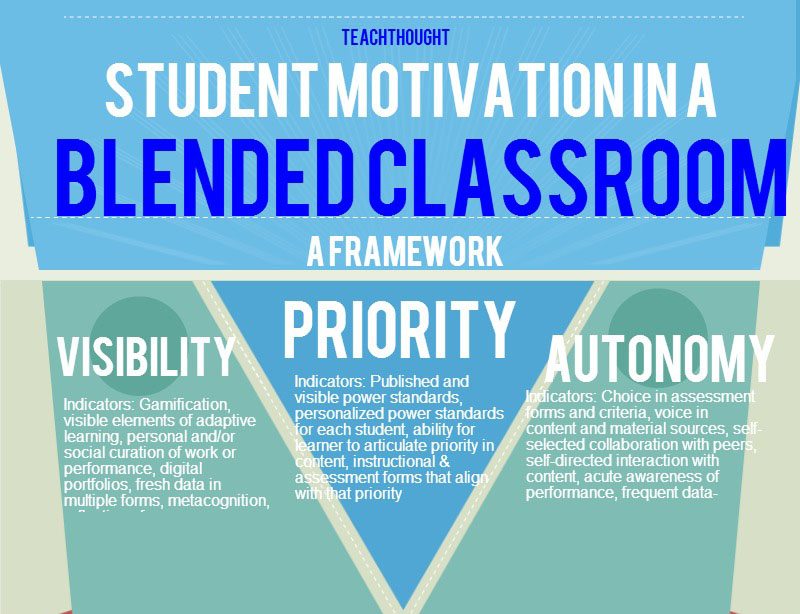
Student Motivation In A Blended Classroom: A Framework
by Terry Heick
Student motivation is an obscured piece of the academic puzzle, if for no other reason than what it implies: That students are inherently demotivated, and that the source for motivation is usually external.
It’s also difficult to measure, and education at large has become infatuated with researching, measuring, and charting every step of the learning process. This has had the ironic result of putting it at odds with abstractions of understanding, including curiosity, creativity, innovation, design thinking, agency, self-direction, and other equally endearing components of 21st century learning.
Universal catalysts for motivation include curiosity, choice, agency, and self-efficacy, whether in an academic environment, creating art, or performing athletically. A blended learning classroom, where students access both instruction and content in the classroom and online, is no different in that respect; a student’s ability to follow their curiosity, recognize and evaluate possible learning pathways, collaborate freely, and interact directly with content and peer sets all impact the confidence, curiosity, and motivation of a learner.
Additionally, the ability to self-monitor and adjust cognitive ambition, potential models, and the relative quality of their own thinking and performance are each factors in student motivation. That these ideas are seemingly divergent makes is troublesome, so a framework might make sense to help unify the concepts.
Autonomy
Blended Learning isn’t simply about giving students access to resources online. Narrow learning pathways with tightly sequenced access to content, pre-written assessments, and externally-sourced quality criteria only serve to homogenize an already mediocre learning model. Student autonomy, self-direction, and flexibility, at worst, decenter the teacher and place the student at the center of their own learning experience.
Indicators: Choice in assessment forms and criteria, voice in content and material sources, self-selected collaboration with peers, self-directed interaction with content, acute awareness of performance, frequent data-based adjustments, multiple (and self-selected) data sources
Priority
Like all high-performing classrooms, a clear priority of content is helpful. This starts with establishing high-priority—and highly complex—academic standards (often called “power standards”). These standards are not only more “enduring” for students, but also serve to anchor more discrete skills and concepts.
Further, as a matter of personalizing learning, each student will ideally have priority content that fits their own learning needs based on both data, teacher observation, and self-awareness. In that way, content priority is rarely the same for two students.
Indicators: Published and visible power standards, personalized power standards for each student, ability for learner to articulate priority in content, instructional and assessment forms that align with that priority
Visibility
Visibility starts with curriculum, continues with the parsing of content for students, the distribution methods (including YouTube and social media), potential assessment forms, learning pathways, and assessment performance data; also includes “informal”/non-traditional data, student self-selected data points, and the visibility of available materials, models, peer sets, and other resources for student progress.
Indicators: Gamification, visible elements of adaptive learning, personal and/or social curation of work or performance, digital portfolios, fresh data in multiple forms, metacognition, reflection of learning/progress, etc.
Iteration
Complex and challenging material takes practice, a reality at the center of iteration. Also at work here is the need to constantly revisit old thinking, collaborate on select portions of learning, and to allow for design thinking to grow.
Indicators: practice, unique data that inform need for practice, content packaging that promotes iteration (e.g., project-based learning) revision of existing work or portfolio items, design thinking, maker spaces
Product: Personalized Learning
The end result of this approach, ideally, is “personalized learning”—the underlying assumption of course being that authentically personal and personalized learning would be inherently and organically motivational.
Of course, it’s not that simple. In a system where mastery of dozens of externally-designed academic standards is pursued by incredibly divergent schema and literacy levels, true intrinsic motivation (or personalized learning for that matter) is problematic, if for no other reasons than standards, delivery methods, accepted mastery levels, assessment forms, and so much more has been decided long before a student sets foot in a classroom.
Nonetheless, the above framework can help support the teacher in a blended classroom in promoting student motivation, in large part through self-direction, and the idea of iteration.
Image attribution flickr user jasmic; A Framework For Student Motivation In A Blended Classroom

